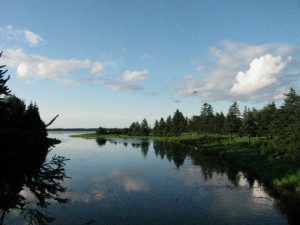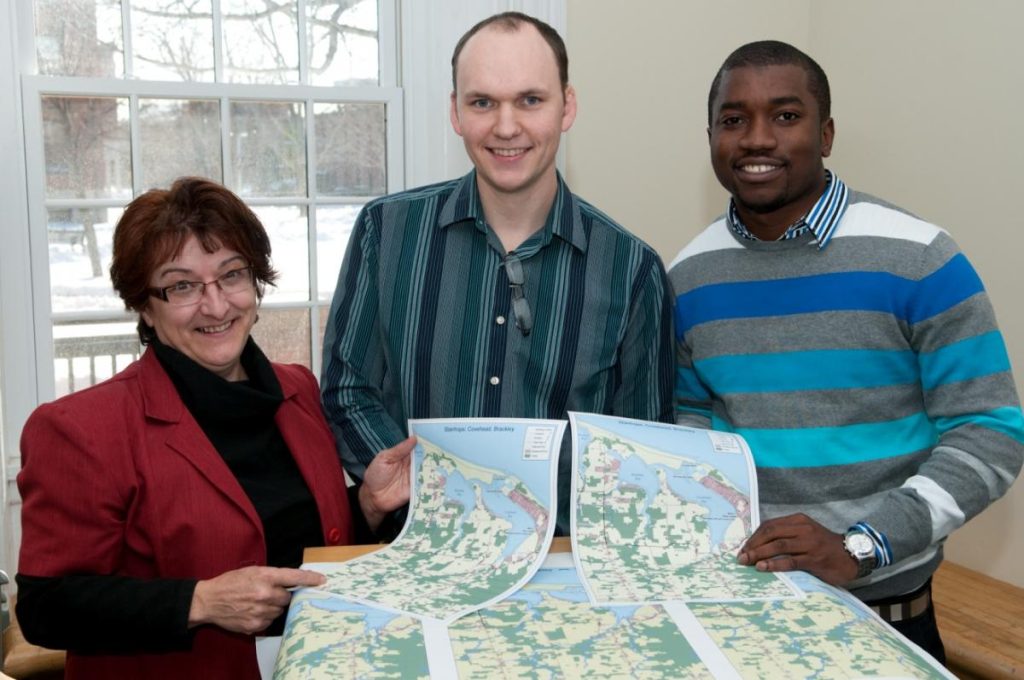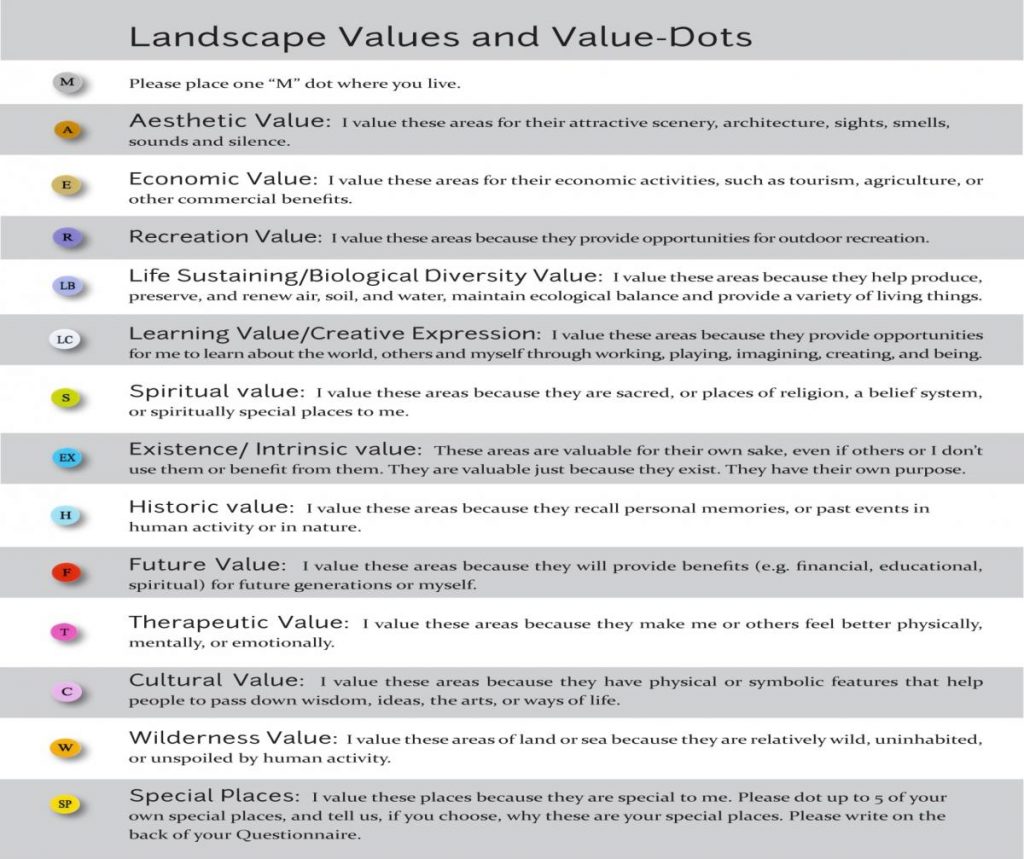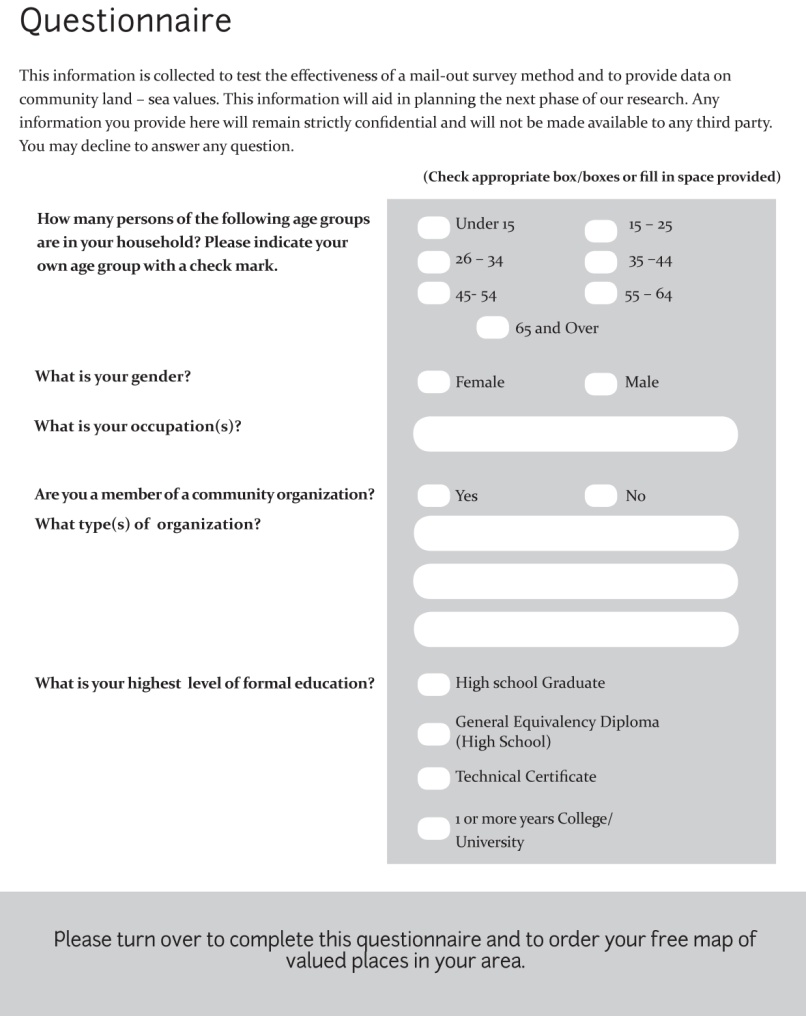Values Mapping Research Project (2011)
Socio-cultural Values Mapping Research was a 2011 Institute of Island Studies research project that generated basic information on how geographic sites are most valued by residents and non-resident landowners. This data augments physical, biological, and economic information and provides critical planning resources necessary for making decisions about community development and adaptation.

The province of Prince Edward Island, being an island, offers a manageable geographic space with clear boundaries and jurisdictional powers within which to conduct research that can model and provide insights into issues of social, ecological and economic concern. As climate change unfolds, Prince Edward Islanders will be vulnerable to impacts of sea level rise, salt water intrusion, and erosion. Islands will also increasingly be active sites for research into climate change impacts and human responses, and UPEI is part of a community examining and modeling these adaptations.
Novaczek, I., MacFadyen, J., Bardati, D., & MacEachern, K. (2011). Social and cultural values mapping as a decision-support tool for climate change adaptation. Institute of Island Studies, University of Prince Edward Island.
Update from August 2020: The Values Mapping project and report recently came to the attention of the Pacific Northwest National Laboratory (PNNL), based in Washington State, USA, and has been incorporated in a major report: “OES-Environmental 2020 State of the Science Report: Environmental Effects of Marine Renewable Energy Development Around the World.” The PNNL report is available here.
THE TEAM
The Values Mapping team comprised (left-right) Dr. Irene Novaczek, Team Lead; Dr. Josh MacFadyen, Researcher; Fogho O. Ikede, Research Assistant; and Chrissy Cerminara, Researcher.


THE SURVEY
The survey measured the following values: aesthetic, biodiversity, creative, cultural, economic, future, historic, recreational, special places, spiritual, therapeutic, wilderness.
The survey package consisted of instructions, a map, a set of sticky-dots, a list showing the landscape values and a questionnaire. (Click images to enlarge)
MAPPING FEEDBACK
Aesthetic Values The aesthetic value of landscape can be broken into four subcategories: wildlife, sunset/rise, beauty/view, and sounds. Respondents wrote about the aesthetic value of wildlife, mentioning eagles, foxes, blue herons, and birds in general. Sunsets and sunrises were popularly mentioned, using words such as wonderful, attractiveness, paradise, priceless, and million-dollar view to describe what people enjoyed seeing in their special places. Ocean and bird sounds, peace, quiet, and silence were what people liked to hear in their special places. One respondent eloquently described their special place as “the landscape that folds into the North Shore is especially spectacular against a sunset or sunrise. I love the sounds and smells and omnipotence of the Gulf.”
Biodiversity Values Within the value of “life-sustaining/biological diversity,” respondents expressed concern over protecting marine archaeological sites, oceans, and bays; to be careful with clear cutting for new developments; the abuse of the dunes; keeping the land clean and non-polluted; and protecting shore birds, the wilderness, and other animals living there. One respondent recalled the changes over the years of the shore: “The shore has changed more during the past several years than it had since the Causeway was built to Robinson’s Island in the 1940s.”
Creative Values Respondents mentioned the value of “learning and creative expression” in regards to learning, specifically with the need for more interpretation areas: “It would be wonderful to have appropriate interpretations,” and more information about the original peoples of PEI. For entertainment, one respondent mentioned the community hall as a special place.
Cultural Values The landscape value of “culture” can be broken into four subcategories. These four categories are art, theatre, religious place, and museums. The category of art was mentioned twice in regards to culture in our questionnaire, specifically Dunes Studio Gallery: “The Dunes is special because of its variety – beautiful gardens, pottery, and world culture.” Two people mentioned supporting artists in the area with a school and place to show their work. Theatres were mentioned by one person as a special place to visit; however, they are not within our mapping boundary. One church was also mentioned, as well as one museum.
Economic Values Economic value was mentioned in regards to special places within only two subcategories: economic places and employment. One respondent mentioned working at the Covehead wharf and one as a lifeguard when younger. In fact this respondent was the first lifeguard at Brackley Beach! Some economic places mentioned were Howe’s Hall, Dunes Studio Gallery, motels – specifically North Winds and Gregors – Dougin Mae Collins’ farm, MacKenzie’s Store, Vacation Land Park, theatres, gift shops and galleries, though most of these mentioned were not within our mapping boundaries, such as century farms, canneries, boat building, and blacksmithing in the past, and Covehead Harbour. Going out for hotel meals in general were mentioned, to Richard’s Seafood and the Millstream Restaurant. One respondent touched on a future economic interest: “It would be wonderful to have more and safe biking trails. This is a growing market worth the expense.”
Future Values Looking towards the future, respondents mentioned supporting local artists, and protecting and preserving the wildlife and land. “While change is inevitable, I hope Islanders will preserve as much of their natural heritage as feasible.” Creating memories was an important factor of one respondent’s special place.
Historic Values Many respondents mentioned historical buildings that held a certain significance for them. The buildings mentioned included Howe’s Hall, a museum, a Catholic Church built in 1832, Dalvay Hotel, Covehead Lighthouse, Shaw’s Hotel, and MacMillan Homestead. They mentioned places they visit such as the Pioneer Cemetery: “We like to visit the Pioneer Cemetery of some sailors from the Yankee Gale who are buried there in the National Park”; the first road on the Island: Covehead Road, and Covehead Harbour and Stanhope-by-the-Sea. Many of these places hold important childhood and family memories for people. Respondents also reported past experiences that made these places special to them – everything from walking with a partner who has since passed, to beaches and cottages that they have been visiting for many years.
Recreational Values “This is a great recreation area – just 15 minutes from Charlottetown.” Recreation was a very popular value within the questionnaire. Improvements to the parkway was mentioned as a popular place for activity by all ages. Walking was mentioned as a very popular activity on the new Gulf Shore Parkway, as well as Bayshore Boardwalk trails, the beaches, and along dirt roads where there isn’t much traffic to be concerned with. Biking was mentioned just as much as walking. Special places to cycle were Robinson’s Island, bike paths, and trails. Respondents were happy with the new cycle path: “The cycling path is excellent!” Golfing was another special recreation mentioned by a few respondents: two rather serious and two social golfers. Fishing was also mentioned by only a few respondents. Three of the four respondents remembered themselves or a family member fishing at a special place while one respondent mentioned fishing in the present. A special place for fishing was Cass’s Road, and one person’s father had fished for eels in the past. Heading to the beach was a special activity shared by some respondents and their families. Frequent use of the beach, especially those staying at the cottage, was mentioned. One respondent remembered “…the beach as a favourite recreational site for my troop during WWII Reserve Army training.” A few respondents enjoyed watching nature. Birds such as eagles, herons, and others on the flats and near the fishing boats were mentioned. Summer was not the only time that people got out and had fun. Two respondents mentioned winter activities such as skating on a pond, cross country skiing, and snowmobiling along trails. Other recreation activities that were mentioned were berry picking, clamming as a child, and “Clamming – over the years the best clams in the world!”, swimming at Ross Lane, driving all over the island, and boating and kayaking in the bay.
Special Places Special places that made an impression for many different reasons were mentioned throughout the questionnaire. Covehead was mentioned the most, with Stanhope a close second. Dunes, Rustico, the North Shore, Brackley personal cottages, and Ross Lane were also mentioned a few times by respondents. Natural spaces such as forested areas, the ocean, bays, streams, beaches, and the National Park were all mentioned. One respondent wrote: “These places gave us the first impressive experiences in PEI to which we have been coming back every summer for over 20 years.” Another wrote: ”The special places for me are the estuaries, swamps, creeks, bays, and ocean.” There were many individual spots mentioned, from Gregor’s former hotel, Cass’s Road, an unspecified lighthouse, and MacKenzie’s Store to all the way off our mapping boundary to Dalvay.
Spiritual Two respondents touched on the “spiritual” value when writing about the beach, and relieving stress: “Walking on deserted beaches at sunrise and sunset are virtually spiritual experiences.” The Catholic Church on Covehead Road was mentioned as a special place by one respondent.
Therapeutic Respondents mentioned the therapeutic value in regards to peace, stress, relaxing, solitude, quiet, and enjoyment. One respondent wrote: “There’s nothing more soothing than walking on the beach or swimming – very therapeutic.” While another wrote that being away from the city was peaceful for them, especially when the cars at Oyster Bed are not racing! Others spoke of dealing with the stress of life in their special places where they “can just sit, close my eyes, listen to the waves or nothing at all. I can fly with the seagulls if I choose to! I can sit on a cloud.” For some, their special places were simply just where they could relax or find solitude. Three respondents mentioned the quietness of the place; another found their special places to have therapeutic sounds. While one respondent found the ocean be too therapeutic, another mentioned simply enjoying being near the water.
Wilderness For this questionnaire the value choice “wilderness” seemed to be closely linked with the aesthetic value for respondents. People talked about wildlife and nature as special places for them. “Beautiful wilderness like world-class beaches.”














